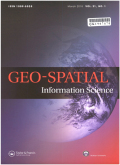- 钛学术文献服务平台 \
- 学术期刊 \
- 基础科学期刊 \
- 天文学、地球科学期刊 \
- 地球空间信息科学学报(英文版)期刊 \
Phenology-based delineation of irrigated and rain-fed paddy fields with Sentinel-2 imagery in Google Earth Engine
Phenology-based delineation of irrigated and rain-fed paddy fields with Sentinel-2 imagery in Google Earth Engine
基本信息来源于合作网站,原文需代理用户跳转至来源网站获取
摘要:
Paddy rice agriculture is practiced in both rain-fed and irrigated ecosystems in the Philippines. However, small farms are prevalent in the region, and current satellite-based mapping techniques do not distinguish between the two ecosystems at farm scales. This study developed an approach to rapidly map irrigated and rain-fed paddy rice in Iloilo, Philippines at 10 m resolutions using Google Earth Engine. This approach used an ensemble of classifiers based on time-series vegetation indices to produce dry and wet seasonal maps for the entire province. Results showed a predominance of rain-fed rice areas in both seasons, with irrigated rice making up only one-fourth of the total rice area. The overall accuracy was achieved at 68%for the dry season and 75%for the wet season based on ground-acquired points and very high-resolution imagery. The two types of paddies were classified at accuracies up to 87%. Furthermore, the land cover maps showed a strong agreement with the municipal statistics. The resultant maps complement current official statistics and demonstrate the prowess of phenology-based mapping to create paddy inventories in a timely manner to inform food security and agricultural policies.

推荐文章
基于Sentinel-2影像的四川木里森林火灾监测
遥感
'哨兵二号'卫星
大气修正植被指数
燃烧指数
森林火灾
基于Sentinel-2和Landsat8 OLI数据融合的土地利用分类研究
Sentinel-2
Landsat8OLI
数据融合
遥感
随机森林
土地利用
应用Google Earth更新电子航道图研究
Google Earth
ENC
HPD
基于Google Earth软件的车载导航数据显示
导航定位
GPS
GoogleEarth
KML
内容分析
关键词云
关键词热度
相关文献总数
(/次)
(/年)
文献信息
| 篇名 | Phenology-based delineation of irrigated and rain-fed paddy fields with Sentinel-2 imagery in Google Earth Engine | ||
| 来源期刊 | 地球空间信息科学学报(英文版) | 学科 | |
| 关键词 | |||
| 年,卷(期) | 2021,(4) | 所属期刊栏目 | Articles |
| 研究方向 | 页码范围 | 695-710 | |
| 页数 | 16页 | 分类号 | |
| 字数 | 语种 | 英文 | |
| DOI | |||
五维指标
引文网络
引文网络
二级参考文献 (0)
共引文献 (0)
参考文献 (0)
节点文献
引证文献 (0)
同被引文献 (0)
二级引证文献 (0)
2021(0)
- 参考文献(0)
- 二级参考文献(0)
- 引证文献(0)
- 二级引证文献(0)
引文网络交叉学科
相关学者/机构
期刊影响力
地球空间信息科学学报(英文版)
主办单位:
武汉大学(原武汉测绘科技大学)
出版周期:
季刊
ISSN:
1009-5020
CN:
42-1610/P
开本:
16开
出版地:
武汉市珞瑜路129号武汉大学测绘校区
邮发代号:
创刊时间:
1998
语种:
eng
出版文献量(篇)
958
总下载数(次)
0
总被引数(次)
2719
期刊文献
相关文献
推荐文献
- 期刊分类
- 期刊(年)
- 期刊(期)
- 期刊推荐
力学
化学
地球物理学
地质学
基础科学综合
大学学报
天文学
天文学、地球科学
数学
气象学
海洋学
物理学
生物学
生物科学
自然地理学和测绘学
自然科学总论
自然科学理论与方法
资源科学
非线性科学与系统科学
地球空间信息科学学报(英文版)2022
地球空间信息科学学报(英文版)2021
地球空间信息科学学报(英文版)2020
地球空间信息科学学报(英文版)2019
地球空间信息科学学报(英文版)2018
地球空间信息科学学报(英文版)2017
地球空间信息科学学报(英文版)2016
地球空间信息科学学报(英文版)2015
地球空间信息科学学报(英文版)2014
地球空间信息科学学报(英文版)2013
地球空间信息科学学报(英文版)2012
地球空间信息科学学报(英文版)2011
地球空间信息科学学报(英文版)2010
地球空间信息科学学报(英文版)2009
地球空间信息科学学报(英文版)2008
地球空间信息科学学报(英文版)2007
地球空间信息科学学报(英文版)2006
地球空间信息科学学报(英文版)2005
地球空间信息科学学报(英文版)2004
地球空间信息科学学报(英文版)2003
地球空间信息科学学报(英文版)2002
地球空间信息科学学报(英文版)2001
地球空间信息科学学报(英文版)2000

 免费查重
免费查重










